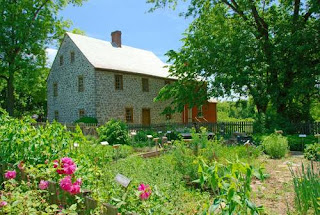Therefore, we're ending our adventure along the WB&A on a more upbeat note, where the trail has already been developed and there are activists and municipal officials who appreciate the economic development to be had in trail towns and are doing something about it.
Our story takes us back to Prince George's County, where trains from Washington carried passengers through Glenn Dale to the popular race track at Bowie before continuing across the Patuxent into Anne Arundel County and on to Baltimore. Right now, the trail stops at the river. (The crossing is on Governor O'Malley's "to do" list, though.)
The Prince George's segment is a popular recreational attraction because of the interesting landmarks and the proximity to neighborhoods and the Bowie State University nearby. The trail even takes you under Race Track Road.
Where it doesn't take you, however, is into the Historic District of Bowie. And that is what the residents of Old Town Bowie want to correct with a 1,200-foot stretch of new trail to carry visitors to the Bowie Train Station Museum and the center of town.
This spur would not only link their neighborhoods but also boost local small businesses by further capitalizing on the area's history.
 Bowie was once a major railroad junction in the 1800s, and vestiges of that heritage remain at the old depot, now a railroad museum (note caboose next to the tower.) This is where people can learn about the area's history while also watching today's trains run along the Amtrak and MARC lines to Washington, D.C., and the CSX line that carries freight up and down the East Coast.
Bowie was once a major railroad junction in the 1800s, and vestiges of that heritage remain at the old depot, now a railroad museum (note caboose next to the tower.) This is where people can learn about the area's history while also watching today's trains run along the Amtrak and MARC lines to Washington, D.C., and the CSX line that carries freight up and down the East Coast. Connecting this to the trail would bring more people to the antique shops, restaurants, and other stores in Old Town. It would also create a safe pedestrian underpass under the Route 564 bridge, which bisects Old Bowie.
So it is encouraging this citizen-based initiative received a $40,500 engineering study from the Bowie City Council to study the design in time to apply for an SHA grant that could pay for half the cost of construction.
Hopefully historic Bowie will be joining the ranks of "Trail Towns" who benefit from visitors as well as locals using this transportation mode.
Speaking of our good friends from State Highway, they bestowed a $30,000 grant upon the City of Frederick to help provide a critical link in their trail system.
You can see the existing trail along the Carroll Creek in downtown Baker Park. The City envisions carrying this popular pathway to a historic landmark, the 1758 Schifferstadt Architectural Museum, and eventually under US 15, which divides the eastern and western sides of Frederick, where it will connect with another existing trail.
This project, which includes historic markers, is scheduled to begin this spring and be completed by summer.
There are still more segments to complete and more money to compete for before Frederick's dream will finally be realized. But it is citizen activists, city planners, and a willing council that keep it moving along -- benefiting the visitor industry, creating recreational opportunities, and providing healthy transportation options for residents.






No comments:
Post a Comment